#historically I have worn more jackets then coats.
Note
will the rye ever be in a different kind of clothing (ie a jumper instead of a coat) ?
Yes !
#letters to rye#ask game#It's funny you ask that cuz most of the time I am not wearing coats. The coats I have worn the most are lab coats for school. I have one#properly called coat; it is long and cool. The only downside is that its pockets are all holey. I don't wear it much. Currently and#historically I have worn more jackets then coats.#Thanks for the ask!!
5 notes
·
View notes
Note
so i am newly in a wheelchair which has been a Massive gain in my ability to go out and about. but i realized that i have aprox 0 clothes that look Good while seated. its a completely different silhouette and i am at a loss as to what to do for it. do you have any suggestions for what could look good seated? preferably no skirts or dresses.
Edit: Check the notes for more people's input, including actual wheelchair users who know much more about what works than I could!
Congrats on chair acquisition!!
Since you're sending this to me specifically I am working under the assumption that you mean to do some amount of sewing.
A high waisted silhouette definitely works best for sitting. I make all my pants with the waistband at my natural waist, and a bit of pleating or gathering at the back just like they did on 18th century breeches, and I've never noticed any particular discomfort from sitting in them. (I think high waisted pants are more comfortable in general, and that low rise jeans are evil.)
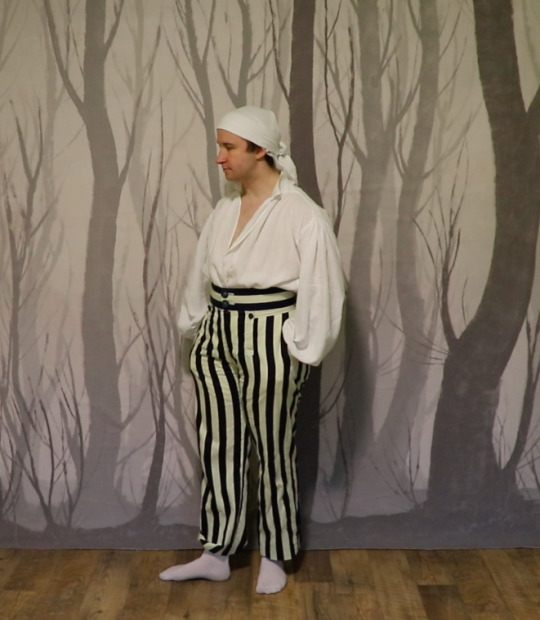
It's something I've never really thought about before, but sitting is a very legs-forward position, so perhaps a colourful or fancy stripe down the side would work well.

(I made this pair 10 years ago and they didn't fit well and are long gone, but I should do a better version someday...)
Or some other form of side seam decoration, like these fabulous button tabs.
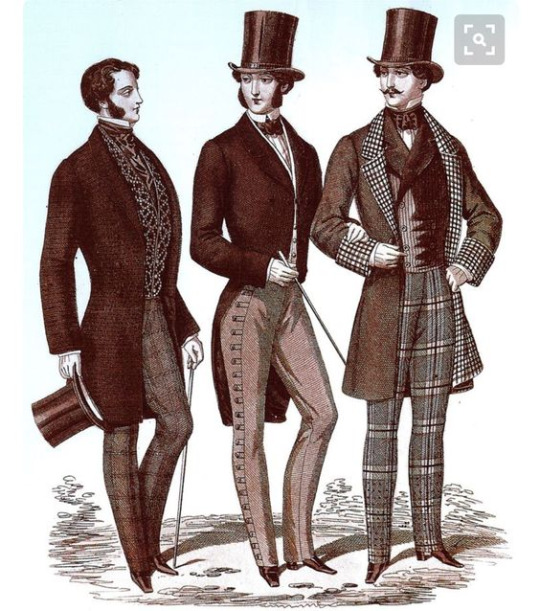
(I don't know what the source for this mid 19th century fashion plate is.)
Cropped jackets would also be good. The first thing that comes to mind for me is the Carmagnole, which was a style worn by French revolutionaries. It's got a pretty similar cut to a regular 1790's coat, just shorter.


(Source)

(Source)
And there are other styles of short jacket, like this one from a few decades later.
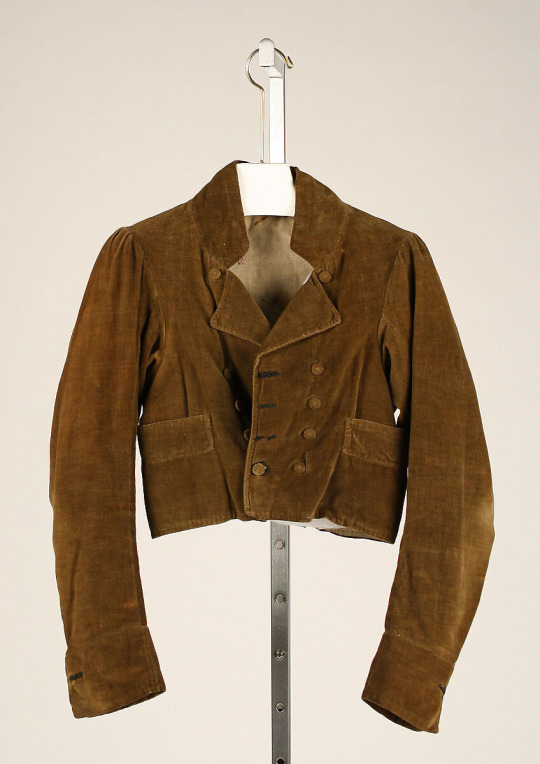
I think it might be possible to get a similar effect from cutting down a thrifted corduroy jacket, depending on the pocket placement? It's not something I've done myself though.
A fancy little bolero could be a lot of fun too! I quite like these ones made by Marlowe Lune. Super easy to sew, and could be patterned by cutting down a bigger pattern that fits the torso.

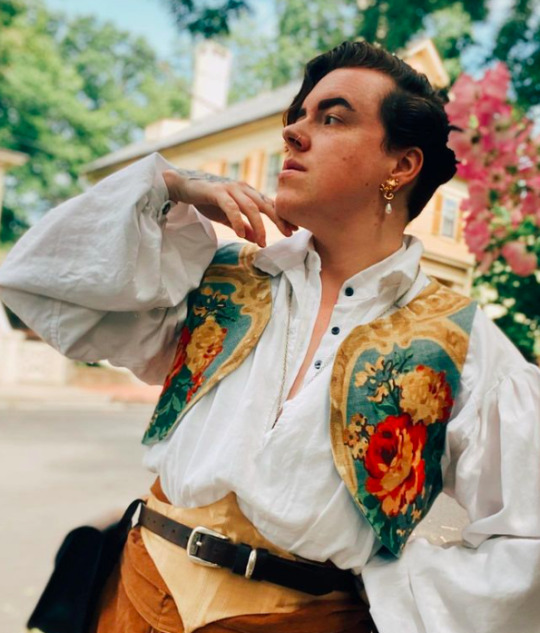
They'd be a good thing to try if you have a smallish piece of fancy fabric, or a small bit trim to use, or want to try a small amount of embroidery.
There are lots of historical styles with sleeves too, and all sorts of decorations.

(Dunno the source for this one either, unfortunately, but the pin says 1880s reception dress. I think a little jacket like that would look good with a puffy shirt and pants.)
Short capes might be practical too, and the late 19th and early 20th century have tons of fancy capelets for inspiration, like this one.

Or this one.

I hope this is somehow helpful! I don't know if you're looking to sew things from scratch or to buy and alter stuff or what, and I have no personal experience using a wheelchair, but these are the best things I can think of for a suitable silhouette.
Dramatic sleeve/shoulder puffs would also be shown off to great effect, if that's something you'd like to wear.
691 notes
·
View notes
Text
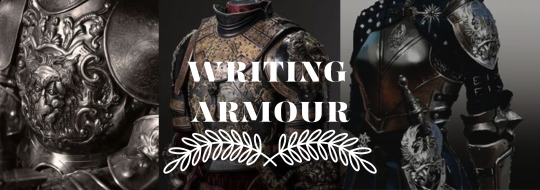
Writing Armour
Types of Armour
All types of clothing provide some protection.
For street fights where you have a couple of teenagers brawling, it would be appropriate to dress them in jeans and a jacket. For more protection, a quilted winter coat or a morotbiker's thick leather jacket, perhaps.
Leather, especially when treated and straightened, offers good protection against arrows, swords, and spears.
The historical armour will include glued-together layers of fabric, thin wooden or bone platelets sewn onto cloth. For wealthier and more advanced societies, metal would be used.
An armour has many parts, and you'll want to describe them with varying levels of detail. However, here are the basics:
A cuirass is a breastplate, protecting the heart and abdomen.
Greaves are shin guards, usually strapped on, protecting the front fo teh lower legs.
Arm guards (bracers)
Helmets
Modern armour will involve a bulletproof vest (which may also be knife-proof). It can be stiff and heavy, and the wearer will sweat under them.
The body armour can lose its effectiveness after a few years.
Disadvantages of Armour
The typical armour (made of steel) is heavy and clunky. In a few hours, your hero is likely to be sweaty, hot and stinky on the inside.
Armour restricts mobility.
Every armour have gaps (the wearer needs to breathe!), and a clever fighter will aim for the chinks.
Shields
Shields are held by the hand rather than worn, so larger shields will be cumbersome and heavey to move, while smaller ones will offer only partial protection.
Shield often consise of wooden frames with leather, hides or metal. They may be painted with heraldic emblems, scary faces, or with magical pentagons.
A shield can also be used as a weapon, like ramming it under the opponent's chin or slamming it down his feet.
The smaller fighter can use a shield well to their advantage, since a shield of the same size will have fuller coverage of their body. However, they will need a strong arm.
Units of githers may use shield formations, such as the tortoise of the Roman legions, the shield wall of the Vikings, and the Greek hoplites shielding not only themselves but the man next to them.
This post is for writers who are trying to bluff their way through a fight scene with minimal knowledge! For full-fledged scenes, I recommend more research.
If you like my blog, buy me a coffee☕ and find me on instagram! 📸
#write#writing#writers and poets#writers on tumblr#helping writers#creative writing#writeblr#creative writers#resources for writers#let's write#writerscommunity#writers#authors of tumblr#poets and writers#armour#weapon#fight scene#character description#fiction#fantasy#action scene#armor#weapons#historical fiction#historical fantasy#writers life#writers block#writers community#writer stuff#writing process
204 notes
·
View notes
Note
kk wow you went so much more in depth than i thought but that was awesome. sending another but pls take all the time you need to answer this one.
i don't think i realized you had a colored version of two of them til today because i was going off of the sketches you posted at the start of the month. the one that caught my eye in that and who i have a different perspective of now that i've seen full color is the shortest hero. you mentioned that the clothing didn't come from any one culture, but if you have an answer it would be cool to hear: what's the long cloth hanging off of the waist belt of this hero called? or, if it's part of the belt, what's the name of the full thing?
[ also a more in-universe follow-up: am very curious about the symbols all four have on their clothing and what your thought process was behind each. i'll settle for the shortest hero's butterfly-esque symbol if you just wanna do one (: ]


Thanks for sending another ask!! This is probably going to get quite long again!
So first, to answer the question, there’s actually not a very easy answer for what that long cloth is called! It shows up quite often in fantasy outfits and armor of knights, and you might sometimes find it being called a tabard or a surcoat online. Really though, it’s closer to something called a monastic scapular, which is a western Christian garment that hangs over the shoulders and goes down to the knees.
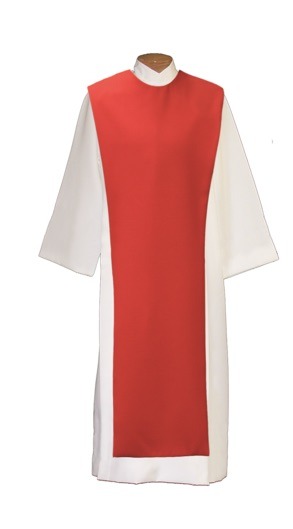


The tabard is usually some form of light tunic or jacket worn over chainmail and underneath armor, and I think in fantasy armor the stylization of it as longer and thinner towards the bottom eventually turned it into a pretty common thing? But the point is that it’s usually attached to something hanging from the shoulders and not just from the belt. But having something hanging in front of the crotch from the belt does have some precedence in the Roman pteruges, so this might be where that kind of belt fabric came from.
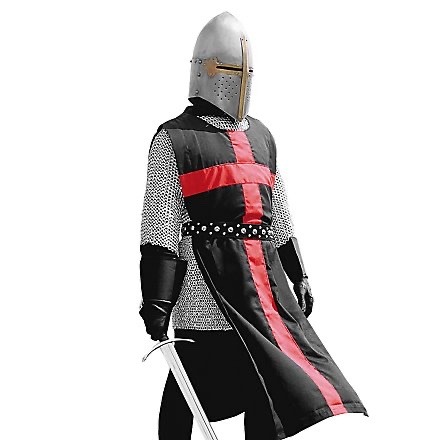
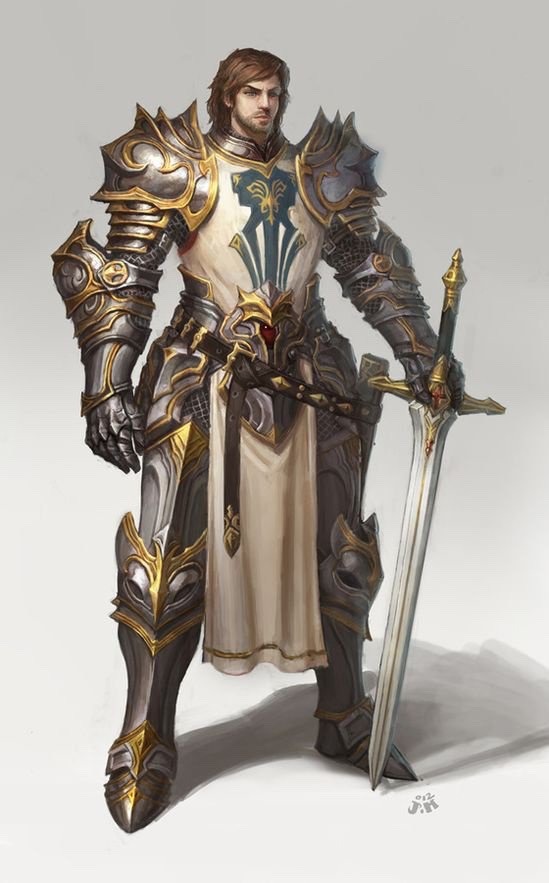
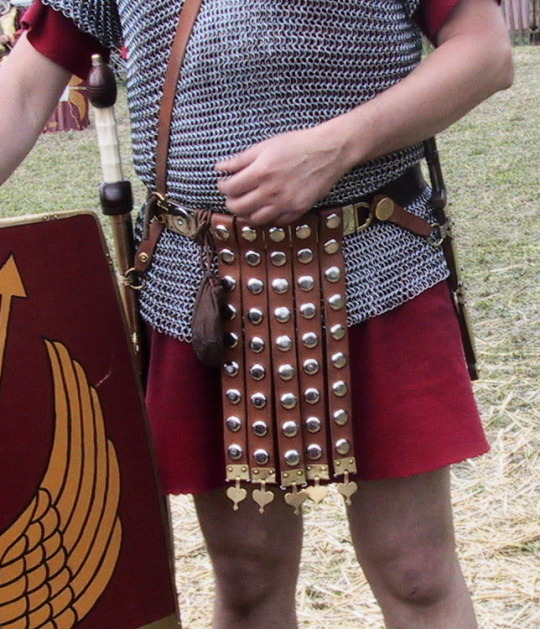
So in the hero of yore designs, the pieces of fabric hanging from the belts aren’t actually very historically accurate, and follow more the trends of fantasy outfit design. But mostly they act as a sort of conisistent point between all the heroes that shows each hero’s insignia. This sort of hanging centerpiece of fabric has been a pretty consistent part of my designs for a really long time, though in my previous Kirby designs this mostly took the form of some part of a double breasted coat, like so:

But yeah! On another note, while the hero of dark’s outfit isn’t based on any specific culture, the hero of soul’s (the butterfly hero) outfit definitely is based on Japanese clothing! The very long sleeves are based on furisode, but there are some liberties I took with the whole design as a whole, I.e. the pants are based on hakama in construction and shape but don’t actually have all the pleats a hakama should, and have added slits for style. You generally also wouldn’t wear hakama with fancy long kimono I think, nor would you use a tasuki with it. Tasuki are generally used to keep the sleeves out of the way while doing activities, while long sleeves are more ceremonial and decorative. I did intentionally keep the sleeves very long on the design, however, for character reasons that I might go more in depth in if I ever make an individual outfit breakdown post.
I’m sorry I didn’t get around to answering about the symbols! I also have a lot of thoughts about them, so I might also make a separate post about that haha
89 notes
·
View notes
Note
Hi Dani! I love Talon's End so much! I love the writing and Hawk and Shea and the Siblings and Isla and Erich and not so much mom, but I still love her and it's amazing.
Question: How would you describe the usual human clothing of the region? I'm trying to draw my MC (helps with getting to know the character) and I'm not sure of what clothing she'd wear.
Thank you and take care! <3
That's a super good question! I got a little carried away, but hopefully this is at least kind of helpful!
TL;DR: Women mostly wear dresses; men mostly wear trousers. Regardless of gender, clothes tend to be light and loose in style without a lot of ornamentation. Currently though, elegant, ornamental hairstyles are in, and many people are growing their hair out to take advantage of that. Hair length isn't particularly culturally dictated or gendered. Clothing colors usually reflect the seasons' colors in nature, but only members of high society (like MC's family) are really expected to have whole ensembles of the "proper" colors. For those curious, robes aren't at all common due to their association with mages.
Details under the cut!
The area where MC and their family live is relatively diverse, so fashion there has been influenced by a variety of different cultures. Maressea is on the warmer side of temperate with a fair amount of precipitation, so during warm weather, clothes tend to be light and not have too many layers--but coats, jackets, and capes to ward off the rain are common. Even when it's warm, sleeves, trousers, and skirts are usually long, but they tend to be more loose and flowing. During the winter, heavier fabrics are a must, but the styles are relatively similar to warm-weather clothes. Colors are an important part of styling, though. The colors of an ensemble should generally match the colors seen in nature during a given season. This is obviously pretty expensive and, therefore, a thing people will be judged by if they're considered a member of Society. But in situations where no one could reasonably afford multiple dyed garments for every season, people still often use seasonal colors for ribbons, handkerchiefs, and other small items. Even among the nobility, garment patterns and shapes are often relatively simple since the mundane aspects of fabric arts were only revived in the last century. Those who had the knowledge to revive things like lace-making and detailed embroidery are highly sought after, and their services quite expensive.
Hats aren't a big thing--unless they're necessitated by weather--since elegant, complex hairstyles are having a moment (the vibe but not necessarily form of fancy wedding updos). Historically, there hasn't been a major tendency toward long or short hair, regardless of gender, but long hair is stylish due to greater options for the aforementioned elegant hairstyles. (Not quite Hawk-length, though!) Hair accessories like ribbons, combs, and gemstones are common based on what a person has available to them.
Women are usually expected to wear dresses, and men are expected to wear trousers. But some avant garde women (including Sabine) have started wearing trousers at informal events (and formal events, if they're feeling extremely spicy). Some men have begun wearing dresses as well, but it hasn't taken off as much just yet. Robes are sometimes worn, but it's very rare since they're associated with being the garb of mages--not the most popular thing these days. So Hawk's gift had the double sin of being a robe AND not being a seasonally appropriate color.
22 notes
·
View notes
Text
The Last Hours Fashion Pt 2
Chain of Thorns comes out TOMORROW!!!! Just in time, here’s my analysis of the official art by @nicole.deal.art in terms of historical accuracy. I’ve already reviewed the girls’ outfits, so now it’s time for the guys!
There aren’t as many primary sources available for Edwardian menswear, and men’s fashion in general tends to change less from era to era. Men’s business and formalwear has stayed basically the same shape for the past 130 years. Keeping that in mind, let’s look at some of these pictures and see how well they hold up.
James

James looks pretty good! The picture looks like it’s at night, so he’s probably wearing evening dress. The high collar and cravat is a distinctly Edwardian style, as seen in the outfit on the right here:
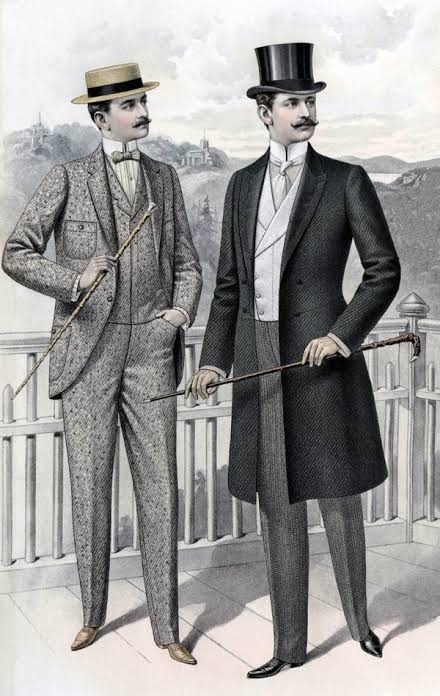
This guy is also wearing a wrap-around waistcoat in a similar style to James’. To make it really accurate, he’d be wearing a hat and jacket, but this picture is obviously showing a fight scene so I can imagine that he lost both at some point. If we’re being really pedantic, James’ hair should also be a bit shorter, but I appreciate that a haircut is probably not high on his list of priorities right now.
Accuracy: 8/10
Matthew

Matthew is a self-described bohemian, and is also very concerned with fashion, so we can expect his clothes to be a bit more colourful and decorated than was possibly the norm. This is also at night, so eveningwear again. It looks like he’s wearing a tailcoat— if you look closely, the cut is similar to the ones in this picture from 1904:
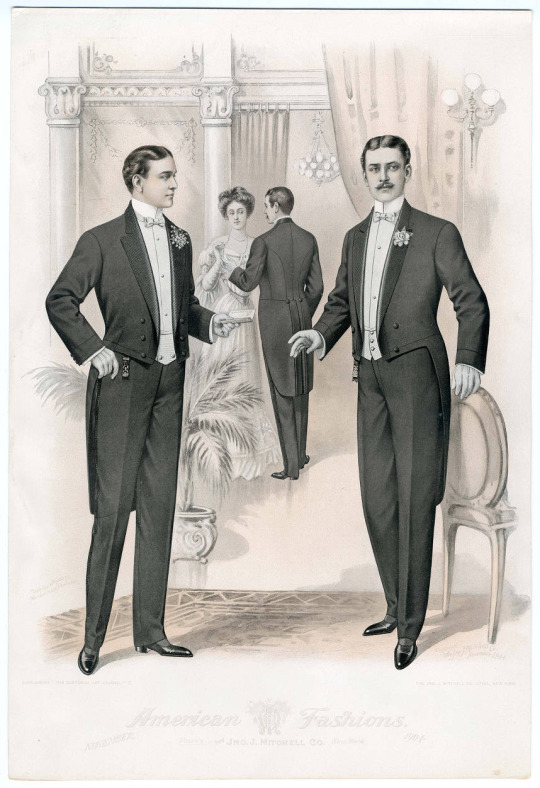
The slight problem with eveningwear is that every source I’ve found suggests that Edwardian evening dress for men was almost exclusively black-and-white tuxedos. In fact, menswear from this time was pretty boring in terms of colour. However, Matthew is, as mentioned, a bohemian, and textually wears very colourful clothing. Same issues as James re: hat and hair, but I can justify it the same way as with James.
And some pictures of cravats for comparison:

The gloves are also interesting. Evening gloves were almost always white, whereas these are dark grey, but I’m prepared to believe they’re either Shadowhunter fighting gloves or worn for warmth in the street after a party.
Accuracy: 7/10
Thomas and Alastair

They’re wearing Shadowhunter gear, which there are obviously no historical references for, so I can’t really analyse it. I’m interested in how their gear differs— Thomas’ seems to be mostly leather, whereas Alastair appears to be wearing a vaguely Georgian puffy white shirt with metal throat, shoulder and wrist guards. We don’t have very many canon images of Shadowhunter gear, so it’s interesting to look at.
On a side not, Cassie said on her Instagram that this picture is of them in an abandoned Paddington Station. I’ve been to Paddington, and the background looks absolutely spot on. Kudos to the artist!
Accuracy: 10/10 just for the background.
Jesse

I don’t have very much to say about this one. The shirt is pretty generic but the trousers are interesting. The distinctive front flap with the two buttons isn’t a style you see with the Edwardians, who have moved on to someone more resembling the modern fly. And yes, I googled “how did the Edwardians fasten their trousers” to find this information. Jesse’s trousers more resemble Regency breeches, as you can see in this pictures:
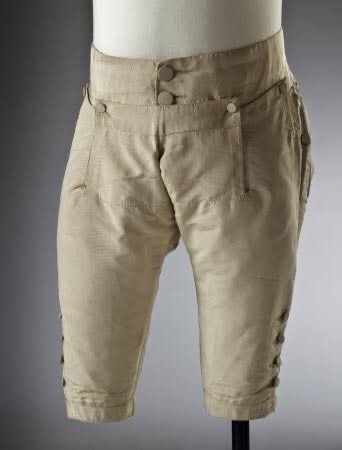
This is interesting, considering the links I drew between Grace’s dress and Regency fashion in my last post. Guess we’ll find out tomorrow if my time travel theory was correct!
The jacket looks like a fairly Edwardian standard coat with the sleeves rolled up. Not much to say except that the deep green colour is possibly slightly unrealistic but it’s a tiny thing.
Accuracy: 6/10
Christopher

Christopher’s hard at work in his lab, and accordingly isn’t wearing fancy clothes. Like Jesse, this is a fairly basic trousers and shirt ensemble that fits pretty well with the period.
Things get interesting when we start looking at the apron and goggles. PPE (personal protective equipment) isn’t strictly fashion, so I had to do a bit more digging into this one as it’s not an area I knew much about.
The goggles could be period inaccurate, depending on how you look at it. The first form of eye protection for welding was developed by the inventor Powell Johnson in 1880. Johnson called his invention “eye protectors” and it was simply two strips of opaque cloth that could be seen through while still offering some protection.
Safety glass— glass coated in plastic to prevent shattering— was invented by Edouard Benedictus in 1903, when TLH is set. However, it wasn’t until 1909 that the first safety glasses were invented by Julius King. So Christopher’s eyewear is about six years ahead of its time. On the other hand, it’s entirely possible that Shadowhunters— probably the Iron Sisters in particular— were using protective eyewear before mundanes and Christopher is simply adopting the technology. But if we’re going by a purely historical standpoint, the goggles are a bit off.
The apron nearly drove me insane because I could not find any sources from the Edwardian era that show a similar style. The best I could find out is that bib aprons have been worn for welding since the 1880, so it’s reasonably accurate. Christopher really needs to pull it up a bit higher, though. Your shirt’s getting scorched, mate. PPE is no joke.
Accuracy: 5/10
As a last note of interest, while I was researching I came across this image I just had to share. It’s a cartoon that appeared in the Tacoma Times in 1903 and satirically depicts “men’s clothing designed by women”. Look at these guys. The og malewives. Poor little meow meows.
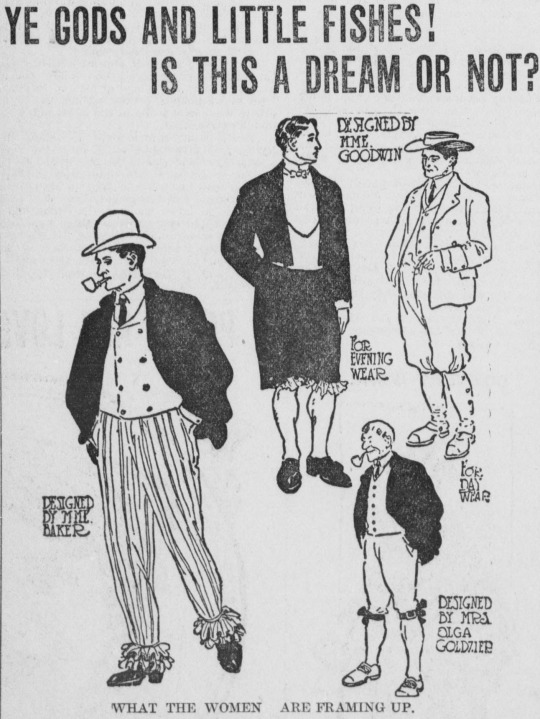
Sources:
Metropolitan Museum of Art Costume Institute
Fashion History Timeline
Vintage Dancer
OHS
Bakersgas Welding
Aaand there we go! I probably spent way too much time on this, but it was fun. I’ll see you all on the other side after I’ve finished Chain of Thorns. Remember to tag your spoilers!
#the last hours#tlh#chain of thorns#chot#james herondale#matthew fairchild#alastair carstairs#thomas lightwood#jesse blackthorn#christopher lightwood#grace blackthorn#the shadowhunter chronicles#tsc#cassandra clare#tsc art#tlh art#history#fashion#fashion history#edwardian#regency#welding
78 notes
·
View notes
Text
Georgian Garments
For my project I wanted to conduct further research into the different types of Georgian garments to ensure that I could create a historically accurate final piece, as well as making it appear as if it belonged in "The Duchess" film.
Women's garments consisted of a relatively relaxed and comfortable form of dress for day-to-day wear whilst also maintaining a level of sophistication and structure through tailored gowns. Women of the higher class would wear "mantuas", a trained gown that was open at the front and draped at the hips with their train pinned up behind . This enabled them to have free movement and comfort during the day. Beneath their mantua would be a "chemise", a knee-length garment composed of linen to prevent skin contact with the expensive silk gown. Chemises would be decorated with ruffles and lace stitched at the neck and cuffs as they were designed to be visible at the neckline and sleeves of the gown. For evening wear, large "paniers" become considered the most formal mode of dress. "Stomachers" became adorned with embroidery, beading, ribbons and quilting. It was shown that the more decorated the stomacher was the more wealth and status she had.
As for men's garments, the silhouettes remained rather feminine, soft shoulders, small waists, full skirts on coats. Basic garments for men would include the three piece suite consisting of a suit coat, waist coat and breeches paired with a shirt and cravat or a stock and solitaire. One aspect of the menswear that really interested me was the range of military jackets worn by Britain during the Georgian period. The British soldiers became known as "the redcoats' due to their striking red coats which made them stand out on the battlefield. These jackets were decorated with golden detailing on the shoulders, collars and chest as well as brass buttons lining the front.


10 notes
·
View notes
Text
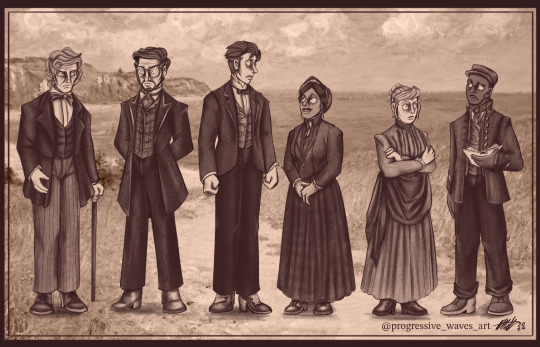

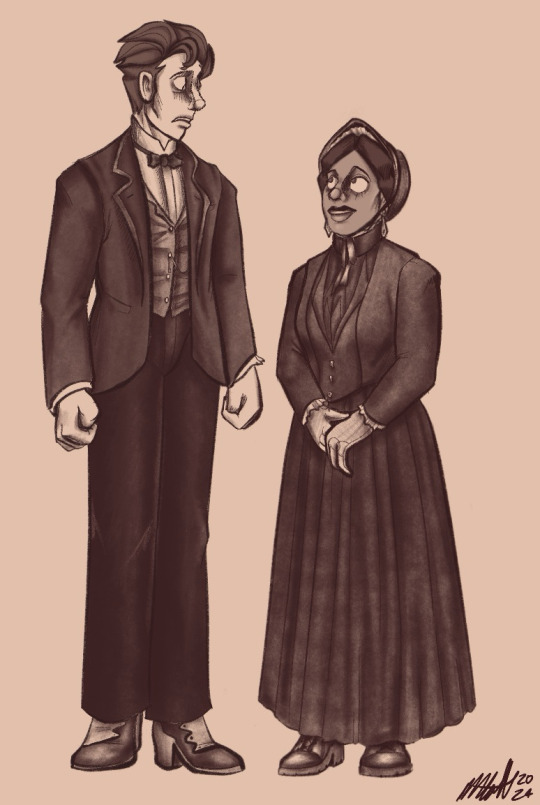
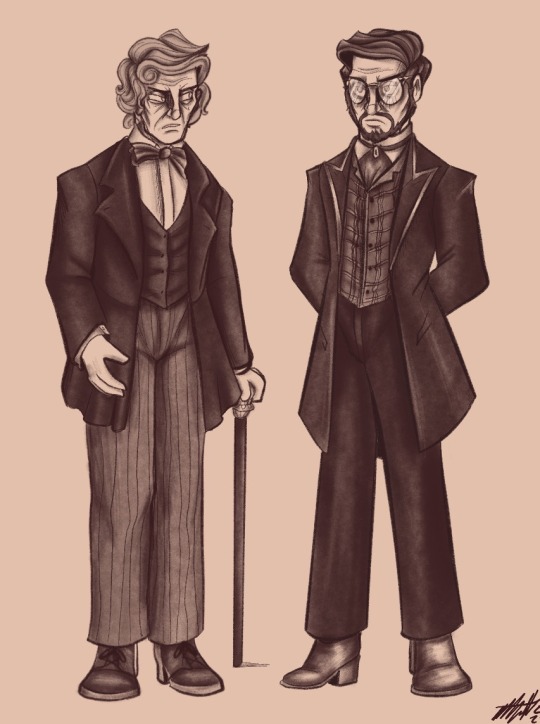

Character lineup, Transitus historical redesign edition. In their sepia tone versions, in actual artwork they’d be drawn against some pretty vibrant painted backgrounds. Come back to me on that. Been meaning to do this for a while!
Have some design notes:
Daniel - Third from left. In @hawthorn-crow’s words: "like a stiff breeze would blow him over." His shoulders/upper body have deliberately been scaled down from that of real-life Tommy Karevik. I don’t know how else to say this but if I were Henry I wouldn’t be easing around in my brother’s personal life if he could drop kick me directly into the sun.
Looks pretty normal, all things considered. The "standout" trait comes from the trust fund kid status: his clothes have a LOT of variety. Literally a different jacket, vest and tie almost every single scene in a period where that was not something easily attainable. Common thing between all of the ‘normal’ outfits is the little watch chain, somewhat prominently displayed.
Abby - Third from right. The exact opposite as Daniel; cycles through two or three outfits maximum outside of her work uniform before 1884. Her box braids are thicker than the original design. Has a pair of emerald drop earrings; gift from the himbo. As for the shoes, homegirl is working minimum 13-hour days, for Christ’s sake, put some treads on those industrial strength high heels.
She likes quilting Why? Cause I said so and wanted her to have hobbies like human beings do. The dress shown here is one fabric/color all the way down, but the seams form a fun little pattern that looks nothing like fire haha what.
Henry - Second from left. Lots of age lines, grey streaks. Visibly much older than Daniel. Loads of aggressive angles, you want a sense of the douchebag aura from a distance. Literally Andrew Carnegie but with none of the redeeming qualities.
Really narcissistic and intent on showing off his status and is thus obsessed with outward appearance. Sharply dressed and deliberately so. Flashy, patterned waistcoats and one very expensive and painstakingly tended to pair of sideburns.
Lavinia - Second from right. Same as Abby, just a few outfits to her name and sturdier shoes. Though she comes off to me as someone who has expensive tastes that can’t be pursued to their fullest extent. Don’t we all.
Pays close attention to new fashion and alters her existing clothes (and hair) accordingly under budget. Is keen on appearing above her station, though not with any malicious intent. More just a desire to fit in and look nice.
Abraham - Far right. The beta version of Abraham of from the earbook bonus pages is peak and this is very heavily inspired by that.
Has not purchased any major clothing items for himself since the mid 1860s; he’s got other priorities. Any new stuff is smaller, and usually cut from the same material as Lavinia’s skirts. Fabrics are worn out (along with their dyes) and lots of layers are worn as a result. Outermost layer that he wears pretty much everywhere on account of it being the only coat he has is a bleached and dyed Union army jacket.
Dee - Far left. Entire character is defined by being stuck in the past. Like Abraham his clothes are very 1860s based but in a more fashion forward and emotionally stunted, "I never got over my wife dying a d am making it my kids’ problem" way, as opposed to the much more reasonable "being impoverished" route.
Hair is also very much mid-century and meant to look out of place next the shorter, clean-cut 70s/80s style that Henry has.
….old. Like basically on death’s door, he kicks the bucket almost immediately after Daniel does.
#ayreon#Just….transitus#man….#So excited to have some genuine notes for their design that work within the era AND inform their characters it is POSSIBLE#tommy karevik#cammie beverly#paul manzi#amanda somerville#johanne james#dee snider#arjen lucassen#character design#character illustration#character sheet#Period drama#the gilded age#1880s#historical fashion#Lavinia’s arms look a little weird but whatever
17 notes
·
View notes
Note
Happy WBW! What type of clothing is popular in your WIP and why? Bonus, tell me something cool/fun/interesting about it! (Could be how it's made, how it's worn, if it's fashionable, etc)
Hi Nopal!💜
You've no idea what you've brought upon yourself! I love fashion history, and this is one area I went hard on historical inspirations. So, be prepared, this isn't very creative of me, just very nerdy😉
One thing I took down a notch though were hats and also hairstyles. I've found that it got distracting in descriptions.
*cracks knuckles*
Here we go, for the Days of Dusk trilogy:
Clothing in the Sunblessed Realm is very much an indicator of wealth, but also class, to the point of it wouldn't be appropriate for someone who isn't a noble to wear certain outfits.
The main inspiration is the Polish-Lithuanian Commonwealth in the late 18th century, however I've ventured a couple of decades into the 19th century for some sources, when I really struggled to find something suitable for the setting.
Nobility
A nobleman's outfit consists of a kontush - a robe reaching past the knees, buttoned up the front. It has slit sleeves that can be unbuttoned and thrown over one's shoulders, in a gesture that usually means you're riling up for a fight. It's worn over a contrasting underlayer called a zhupan, and it's all tied together with a wide, embroidered belt. The colours are often tied to their family's colours or indicate the region they represent at a parliament or another formal occasion. Example in setting: Ianim will usually attend a ball wearing blue and silver.



A noblewoman will wear an ankle-long gown with whalebone stays and bunched up skirts on formal occasions - see my #dress for more references. For more everyday wear, it's something lighter and a little less voluminous. On a colder day she would wear a jacket in a cut similar to that of a kontush - I've seen examples of it being long or reaching just past the hips (e.g. the lady in the middle of the group picture). In setting: if the lady is the head of the house and represents her family's interests at a parliament, she'd also match her outfit's colours to her family's.



And since winters get very cold in this setting, all sorts of fur-lined coats, capelets, and capes are very much in fashion!
And here are some modern day recreations:


Military
Almost all of my characters are in the demon-slaying army, and they wear a uniform most of the time. The uniforms are primarily inspired by Napoleon's la Grande Armée (since that's a super well documented army), however as opposed to the historical inspirations, they are ashen grey - the colour of mourning in the setting.
The uniform consists of a grey coatee of finely woven wool, grey breeches, white waistcoat and shirt, and tall black boots. A greatcoat may be worn in colder weather. The coatee is single-breasted for enlisted Swords, and double-breasted for officers. The colours of facings and turnbacks (exposed lining) signify a Sword's division.
Officers' ranks are denoted by stars on their buttons, from three-pointed stars for lieutenants, to eight-pointed for generals. And yes, this is a terrible design, and there's a running joke that a newbie has to squint at people's buttons to figure out their rank.
But all the other uniformed forces will have bright red, or blue, or green outfits, stealth be damned!
Here are some pictures for reference, just please ignore the hats.



Commoners
While commoners' clothes are be plainer, made of less fancy fabrics, they still are colourful and decorated with trims and embroidery.
Here are some reference pictures painted by Norblin in the early 19th century (a couple of decades out, but unfortunately commoners weren't a typical subject for paintings at the time).





Even more references this way.
Finally, these are the overall current trends, and in a long-lived culture, there's got to be a bit of a fluidity with respect to how fashion changes. That's not to say that everyone who's more than a few centuries old will cling to the fashion of their youths, but they may choose to put a nostalgic twist onto a modern outfit.
15 notes
·
View notes
Text
Witcher Fandom: Costume Historian Weighing In On Episode 1
my first post that’s screenshots next to art/garments they remind me of and a little commentary
Renfri

Important details to highlight:
-Wrap around top with a separate piece as the collar
-Fairly tight sleeves

Portrait of a Young Man; ca. 1508 Hans Süss von Kulmbach, German
NGL I had completely dismissed finding anything for Renfri because of how anachronistic her design seemed to me re: historical design (because of her pants and leather armor) but I was wildly delighted to find this piece. I was drawn to the similar wrap-around structure with a separate collar piece to add stability. In the painting it seems more like a jacket with sleeves that button open along the arm, but I’m still chuffed!
;) hair’s not so different either
Stregobor

Important details to highlight:
-High gathering on the sleeve head- though not a puffed sleeve
-Small ruffle on the cuffs and collar of his shirt/smock
-Unstructured overgown/surcoat (considered somewhat unfashionable/worn by old men by the 1550s)
Originally, I’d placed the silhouette much more in 1500 because of the length of the skirt on his jerkin and his wearing an overgown/surcoat but high neckline, the absence of a true puffed sleeve, and the long line of buttons pushes this forward in time
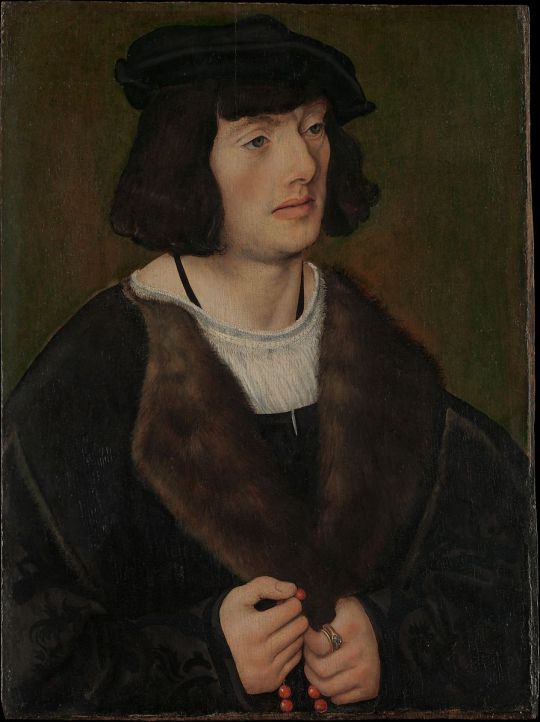
Portrait of a Man with a Rosary ca. 1508 Lucas Cranach the Elder, German
The neckline here is low compared to Stregobor but you can clearly see the kind of overgown/surcoat that Stregobor wears: they were often trimmed with fur, as in this painting, but they were typically fitted through the shoulders and loose around the body.
On the arms of the doublet, you can also see what appears to be a damask or brocade fabric- though much much subtle than Stregobor’s!
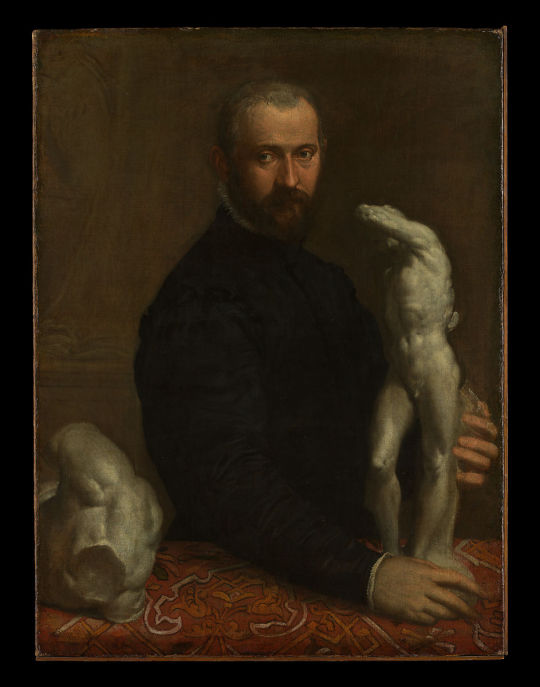
Alessandro Vittoria ca. 1580 Paolo Veronese (Paolo Caliari), Italian
Here we can see a sleeve much more like Stregobor’s- it’s gathered high in the head and tapers down into a slimmer fit on the forearm. We can also see the ruffles of his shirt at the cuff and collar. There’s a line down the front, and I can’t see if there’s buttons because of the image quality, but fabric or thread covered buttons to “blend in” with the garment were also made at the time!
Danek

Important details to highlight:
-Breastplate with vertical striped ornamentation
-Relatively low/smooth line to the pauldrons
-Relatively small/tight spaulders
-A low pigeon breast curve to the breastplate
-Low collared gorget
Hello I know very little about dating armor
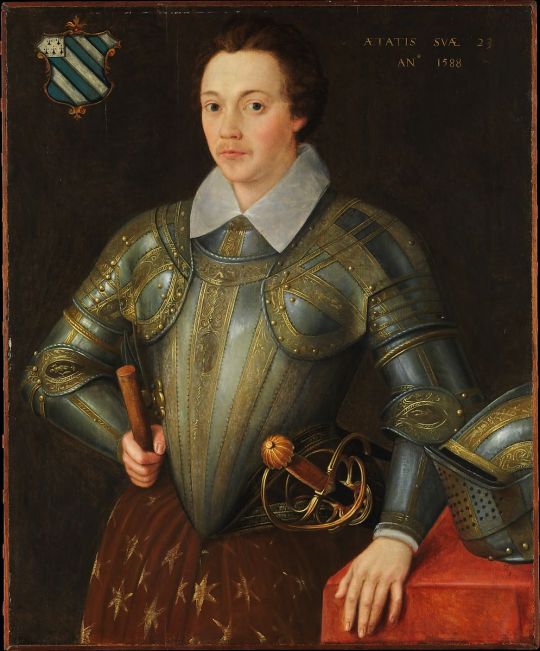
Sir John Shurley of Isfield (1588) British Painter British
Arms and armor are hard for me to date but I feel like these look like contemporaries
Calanthe (helmet)

Important details to highlight:
-High Ridge
-Visored
-Angled Cheekguards
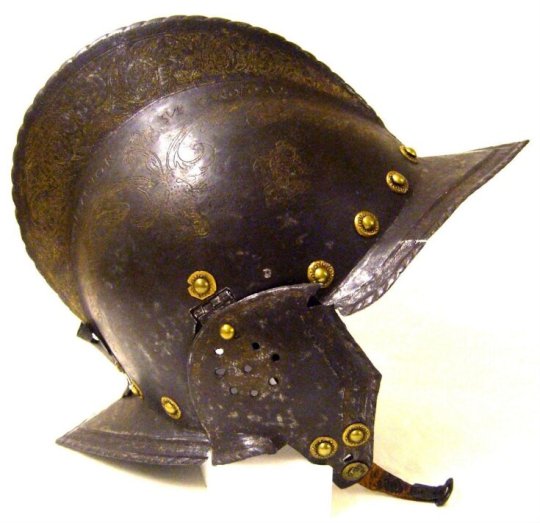
Burgonet ca. 1585 Italy
If I remember correctly, this is the style of helmets worn by pikemen and cavalrymen- the ridge was to redirect the force of a direct bashing blow
Marilka

Important details to highlight:
-Straight cut to skirt
-Low neckline on her smock/chemise
-Waist is high under the bust
We don’t have many dated and easy to discern peasant outfits in the historical record- but what I really like about Marilka’s outfit is that the palette is in a natural and available dye color. Her skirt is in the range of what you can dye with madder and her coat/bodice is a mostly blue / sort of green which you can achieve by overdying woad with weld.

Juni, Brevarium Grimani, fol. 7v (Flemish) circa 1510
As I said above, here’s a good example of the color palette in the historical record. For the closer woman, the blue portion you can see is probably the bottom half of a kirtle which would also have a laced bodice. Marilka could be wearing a kirtle under her jacket: many didn’t have a “front” portion as we would know them- some of them had a full back and just tied across the front to accommodate different sizes. The jacket has short sleeves which would have provided additional protection from the sun and like Marilka they have a v front.
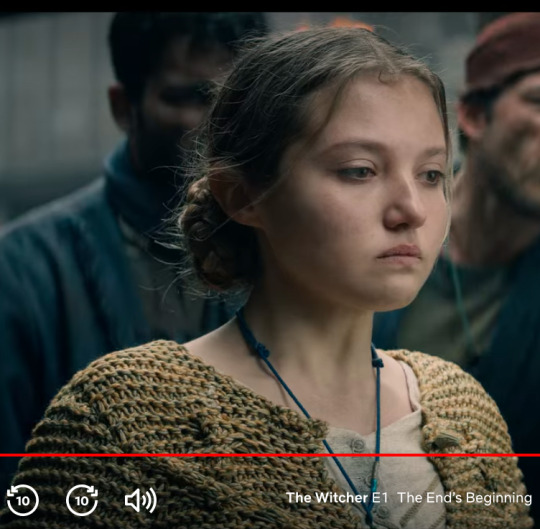
okay hello everyone I am not going to go down the rabbit hole of the history of knitting here too like I’m sorry it’s weird and complicated and hard to explain but TL;DR knit garments of the time were not like Marilka’s they were like this because of complicated political/guild reasons and also the price of labor and wool
The Knuckle Bones Crew
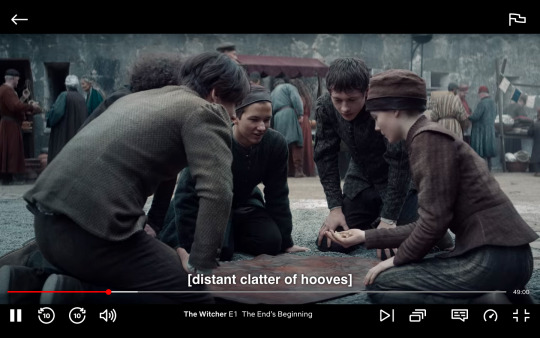
Important Details
-High shoulders to the jackets
-Lack of puffed sleeves, some with shoulder “wings”
-Trunks/Hose are close to the legs
The puffed sleeves generally drop from fashion in the 1560s and the puffed trunks/breeches drop in the 1570s where they become baggy and become more fitted in the 1580s. Though in the 1580s, the doublets generally had longer skirts so I’d generally place this in the 1590s.

Doublet 1605-1610 (made), 1870-1895 (altered) England
This is from a decade later- so the waist line on the jacket has risen a bit. Here you can see the double seams of the sleeves (along the front and back of the arm) that allow for a tighter fit and full range of movement. You can see the shoulder wings here- rather conservative. In the 1590s the wings were wider in length, and in the 1600-1610s they were thicker. Interestingly, along the waist seam you can see small holes/eyelets where the hose/breeches/trunks would lace into the doublet! That lacing held your “pants” up
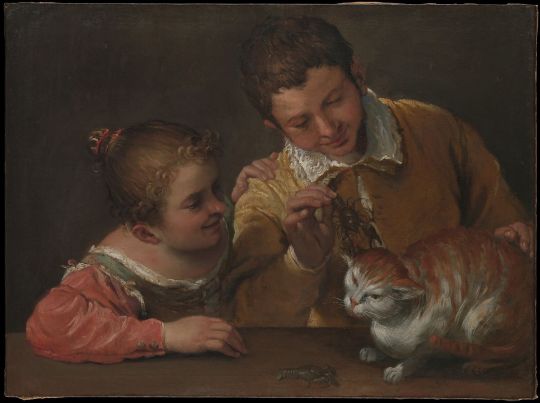
Two Children Teasing a Cat (c. 1600) Annibale Carracci Italian
NGL I just thought this was cute
Ciri

Important Details:
-High Narrow Shoulders
-Sleeves Coordinating (not matching) Body
-Slight puff to shoulders
Separates for women were a thing that we know was common though there’s fewer portraits I can find of it. Women wearing doublets was a trend in the Elizabethan era (c. 1560-1600). I think her full outfit has a separate matching skirt and there’s a peplum on the doublet which did happen.

Portrait of a Lady in Black and White - Alessandro Allori (Florence) c. 1590
This is a rather fanciful example but here we go: a front closing women’s doublet/gown with coordinating sleeves. Under the ruff, there was likely a grown-on collar as Ciri wears. I’m peeved because I know I’ve seen examples much closer to what Ciri wears but I can’t find any right now.
.
I skipped over a few screenshots I originally wanted to do (Eist, the ball guests, and Mousesack/Ermion for sure) because I’d already spent two nights on it but if there’s something you’d like me to unpack- I’d be happy to do it for you <3
#Witcher Fandom: Costume Historian Weighing In#the witcher#stregobor#marilka#ciri#Cirilla of Cintra#cirilla fiona elen riannon#danek#calanthe#queen calanthe#renfri#renfri vellga#the end's beginning#the witcher season 1 episode 1
48 notes
·
View notes
Text
Visuals from: To B With Love
In chapter 3 I introduce the idea of an article of clothing called a mantrless and because I can’t draw for shit, here are some pictures.
What is a mantrless - a cape like or mantle like dress. I imagine these would have become popular for male omegas because mantles & capes have historically been worn by both men and women and they’re super easy to customize for any occasion and into unique fashionable shapes.
This is actually something we’ve see a lot in fashion even today.
Here is an Asian influenced cloak dress. It was heavy inspiration for what Steve is wearing because, look at it.

Another example. Couldn’t find a picture with the jacket closed but I get it, the detail on that waist coat. Chef kiss.

Something a little more evening wear.

And a great example of a steampunk cloak dress that plays on Victorian style

#to be with love#visual aids#I have never wished I could draw as badly as I do right now#I want to draw him so bad and this is a problem#we haven't even really gotten into Billy in cowboy gear yet#send help
18 notes
·
View notes
Note



I'm sorry for spamming more, but... what is the truth? Black? Brown? GREEN?
(No, no, I don't think it's green... but you have to admit, that last one is very green-y.)
The Doctor's coat is the new blue/gold dress.
LMAO, truly it is the debate of our time!!!
but i've been doing some googling, and i know that nine's jacket is basically a replica of a german u boat captain's coat (sketchy choice, tbh, but i respect the fit). in black, those coats look like this:

now, here's the same coat (from the back) in brown:

if it were actually the brown version, i'm convinced it would be very obviously brown in all lightings.
so, i think rtd was just messing with us. or, possibly, because it's meant to not be a prop, but presumably an actual historical coat, he might be interpreting the worn leather and general ageing to the piece as looking "brown" to rose's eyes.
anyway, RIP to my search history which is now full of questionable stuff :/ but the coat is def black, and i stand by that.
15 notes
·
View notes
Photo

Pale Lights - Chapter 23 Trial Participants Lineup Fanart
Massive rearrangement of everyone as the diving crews finally are official.
New info is added. Finally some actual info on Yaretzi.
Inyoni got moved to the section we after this chapter really didn’t want to see her in. EE, why are you doing this to me? That was one of my favorite designs with the nice cool scar! :(
Minor art updates:
Small Ishaan art update as he’s no more sickly looking / pale.
Angahrad got a small update with an added sword belt.
Wardrobe changes:
Zenzele was noted to have a coat, so I updated his look to something more Baroque than Renaissance. Also gave him a tricorn as that is a Malani fashion trend, so seeing how I was taking his wardrobe in a more modern direction it seemed fitting.
Yaretzi got a full wardrobe update. Of course, as we all know Yaretzi is super plain and easy to not notice at all. While wearing basically a full bard outfit of stripes on the top and a patchwork skirt (Yes Tristan. I am judging you and your choice of how to describe people).
Anyway, I had fun finding some historical Aztec references that fitted to that exact combo. Almost. The skirt is woven to have the pattern rather than actual patchwork. No extra full body art, but I know exactly what she’s wearing. Except the shoes. I’m assuming she has shoes, though. Even if only Aztec nobles had them in real life and everyone else were barefooted. ;)
Isabel was noted to wear skirts this chapter. The outfit we last heard described did not have skirts. I’m therefore assuming she changed her outfit even if we didn’t get a thirsty description from Angharad. Probably she dressed a little up again now she can expect to not track through the wilderness. You think Yaretzi had me geeking out with a two-hour research session? Yeah, no. This is me properly geeking out in a whole different way.
Isabel is running out of luggage room for more new clothes. Seriously, a full gown like the first she was wearing takes up room for a full bag and is easily 7 kgs of fabric. And don’t even get me started on transporting big hats. This outfit is done reusing a bunch of items she has worn in earlier art. The yellow satin bodice is the same as the last outfit, but she has dumped the jacket and added “mix and match” sleeves. I figure she has a skirt to match those sleeves, but the layers below that skirt would be the same as used for the yellow brocade dress from the ship. The hat is from that first dress on the ship as well. This means it all in all only is one third extra outfit dragged along. Instead of a full one.
#Pale Lights#Fanart#Cast Overview#character designs#gwennafran art#seriously the shoe thing is the sort of over the top you wouldn't believe in a fictional work#yet it really was a thing#wtf?
3 notes
·
View notes
Text

welcome to notting hill, artemis, rosa, mel and tasha. we're super excited to have you here, you've got twenty four hours to send in your accounts!
HAYDEN CHRISTENSEN. HE/HIM / have you ever heard of HAPPIER by bastille, well, it describes KIRBY CERULLI to a tee! the thirty six year old, and RADIO HOST was spotted browsing through the stalls at portobello road market last sunday, do you know them? would you say HE is more bitter or more SOCIABLE instead? anyway, they remind me of dashed plans, pea coats, hair just long enough to curl at the nape of the neck, and a deep longing for love, maybe you’ll bump into them soon! [ ARTEMIS ] **filling cole's sibling wc**
DIEGO LUNA. HE/HIM / have you ever heard of ODE TO SLEEP by twenty one pilots, well, it describes JAVIER RIVERA to a tee! the forty three year old, and MECHANIC was spotted browsing through the stalls at portobello road market last sunday, do you know them? would you say HE is more curmudgeonly or more WITTY instead? anyway, they remind me of back alley walks home at midnight, closing time at your favorite dive bar, the warmth of a flickering candle flame and the tang of ginger, maybe you’ll bump into them soon! [ ARTEMIS ] **filling clara's husband wc**
MARGOT ROBBIE. SHE/HER / have you ever heard of I KNOW THE END by phoebe bridgers, well, it describes SLOANE CERULLI to a tee! the thirty three year old, and HORROR CONTENT CREATOR (PODCASTER & YOUTUBER HOST) was spotted browsing through the stalls at portobello road market last sunday, do you know them? would you say SHE is more impetuous or more ENERGETIC instead? anyway, they remind me of late nights in places you shouldn’t be in, having no regards for other’s personal spaces, worn out jeans jackets, talking to a camera, historical places and restless nights, maybe you’ll bump into them soon! [ ROSA ] - cole’s sibling wc
MELISA PAMUK. THEY/THEM / have you ever heard of DELICATE by damien rice, well, it describes FEYZA KAHVAS to a tee! the thirty one year old, and SCULPTIST / PAINTER was spotted browsing through the stalls at portobello road market last sunday, do you know them? would you say THEY are more workaholic or more CONFIDENT instead? anyway, they remind me of being holed up in an atelier for days at a time, ink-stained fingertips and clothes, denim jumpers, sending 5 different people the same ‘i love you; you’re the only one’ text but feeling alone all the same, maybe you’ll bump into them soon! [ ROSA ]
SOPHIA BUSH. SHE/HER / have you ever heard of SIMMER by hayley williams, well, it describes TERESA PRESTON to a tee! the forty year old, and HEAD OF NEUROSURGERY was spotted browsing through the stalls at portobello road market last sunday, do you know them? would you say SHE is more resentful or more INDEPENDENT instead? anyway, they remind me of an empty room with a promise of family, self-destructive tendencies, feeling excited at the sign of competition, not fully trusting yourself, maybe you’ll bump into them soon! [ ROSA ]
KRISTIN KREUK. SHE/HER / have you ever heard of BOTH SIDES NOW by joni mitchell, well, it describes LONDON CHOI to a tee! the thirty nine old, and BAKER / INFLUENCER was spotted browsing through the stalls at portobello road market last sunday, do you know them? would you say SHE are more indecisive or more KIND-HEARTED instead? anyway, they remind me of houseplants scattered all over the house, the smell of freshly baking bread, necklaces hanging out of a jewelry box, high heels echoing in an empty hallway, quietly humming while doing chores, maybe you’ll bump into them soon! [ ROSA ] - jay’s baby mama wc
ALICIA VIKANDER. SHE/HER / have you ever heard of THIS IS WHAT YOU GET by paramore, well, it describes FIONNA ‘FINN’ ALEXANDER to a tee! the thirty four year old, and BARTENDER AT HAMMOND’S PUB was spotted browsing through the stalls at portobello road market last sunday, do you know them? would you say SHE are more deceitful or more PLAYFUL instead? anyway, they remind me of making a “fuck you” gesture at authorities, blasting music while driving around the city at 3am, sending nothing but memes in a group chat, the smell of marijuana lingering in the air, setting 5+ alarms and ignoring them all, maybe you’ll bump into them soon! [ ROSA ]
JOSH SEGARRA. HE/HIM / have you ever heard of WAY DOWN WE GO by KALEO, well, it describes GABRIEL RIVAS to a tee! the thirty-seven year old, and DEFENSE ATTORNEY was spotted browsing through the stalls at portobello road market last sunday, do you know them? would you say HE is more cold or more OBSERVANT instead? anyway, they remind me of freshly-pressed suits, avid preparation for his next court appearance, nothing less than perfection & hiding a heart held together by superglue, maybe you’ll bump into them soon! [ MEL / THEY/THEM / TWENTY-TWO / EST ] DANIELLE CAMPBELL. SHE/HER. / have you ever heard of BITTER by fletcher, well, it describes ANNABEL WALLIS to a tee! the twenty-six year old, and DJ AT CLOUD NINE CLUB was spotted browsing through the stalls at portobello road market last sunday, do you know them? would you say SHE is more cocky or more PASSIONATE instead? anyway, they remind me of losing yourself in the sound of the club, slamming doors, chipped nail polish & slept in makeup telling yesterday’s story, maybe you’ll bump into them soon! [ MEL / THEY/THEM / TWENTY-TWO / EST ]
GO MINSI. SHE/HER / have you ever heard of HOMETOWN GLORY by adele, well, it describes AERA KYUNG to a tee! the twenty-five year old, and HERBALIST AT ARIES APOTHECARY was spotted browsing through the stalls at portobello road market last sunday, do you know them? would you say SHE is more unpredictable or more CURIOUS instead? anyway, they remind me of unsent postcards, the calming strum of an acoustic album, canvas tote bags carrying an entire livelihood & fingers littered with thrifted rings, maybe you’ll bump into them soon! [ MEL / THEY/THEM / TWENTY-TWO / EST ]
PHOEBE TONKIN. THEY / SHE / have you ever heard of SPACE ODDITY by david bowie, well, it describes BOWIE LYNN to a tee! the twenty-eight year old, and MANAGER / LIVE EVENTS COORDINATOR AT HAMMOND’S PUB was spotted browsing through the stalls at portobello road market last sunday, do you know them? would you say THEY/SHE are/is more distrusting or more DETAIL-ORIENTED instead? anyway, they remind me of releasing a breath you didn’t realize you were holding , a uniform of baggy clothes and well-loved combat boots , the dirt collecting on the soles of your shoes as you run & brunette locks with a mind of their own , maybe you’ll bump into them soon! [ MEL / THEY/THEM / TWENTY-TWO / EST ]
DIEGO CALVA. HE/HIM / have you ever heard of lost it to trying by son lux, well, it describes EMILIO LUCERO to a tee! the twenty nine year old, and semi-retired pro tennis player was spotted browsing through the stalls at portobello road market last sunday, do you know them? would you say he is more obsessive or more disciplined instead? anyway, they remind me of the courage of selfish convictions , a risen vein running from a white knuckled grip , the overgrowth of ivy on a crumbling balcony and the stinging heat of a blue sky against closed eyes, maybe you’ll bump into them soon! [ TASHA / SHE/HER / 24 / EST ]
2 notes
·
View notes
Text

𝚆𝚛𝚒𝚝𝚒𝚗𝚐 𝙷𝚎𝚕𝚙: 𝙴𝚍𝚘 𝙹𝚊𝚙𝚊𝚗 𝚂𝚝𝚞𝚏𝚏 Mega 𝙳𝚞𝚖𝚙.
I'm basically in love with historical fiction/plots set in the past no matter the time period or where it was. Here's Stuff I have compiled (I'm happy to get suggestions on what else to incorporate or corrections if something on the list is wrong!)
This is for your writing needs perhaps you can incorporate this into your plot, help with character making and or world building etc
•––––––☆––––––•
CLOTHING:
1. Kimono:
- Appearance: A traditional Japanese garment with straight-lined robes, wide sleeves, and a broad sash called an obi. It is usually made from silk or other luxurious fabrics, featuring intricate patterns or motifs.
- Occasions: Special events, formal occasions, religious ceremonies, tea ceremonies, weddings, and festivals.
2. Yukata:
- Appearance: A casual, lightweight cotton kimono, typically made with simpler patterns and fewer layers. It has slightly shorter sleeves and is often worn with a narrower obi belt.
- Occasions: Summer festivals, hanami (cherry blossom viewing), informal gatherings, hot spring visits, or as loungewear.
3. Hakama:
- Appearance: Wide-legged trousers that are pleated and worn over a kimono. Typically, men wear hakama more frequently than women.
- Occasions: Formal events, weddings, graduation ceremonies, martial arts practices (kendo, aikido, etc.), tea ceremonies, and traditional dances such as Noh or Kabuki theater.
4. Haori:
- Appearance: A short, jacket-like outer garment, typically worn over a kimono. Haori often features bold colors, patterns, or intricate embroidery.
- Occasions: Informal gatherings, special occasions, tea ceremonies, cultural events, or as a fashionable addition to modern attire.
5. Furisode:
- Appearance: A formal, vibrant-colored kimono with long, swinging sleeves. Furisode is primarily worn by young, unmarried women and is considered the most elaborate kimono style.
- Occasions: Coming-of-age ceremonies (Seijin no Hi), weddings (for family members), tea ceremonies, graduation ceremonies, or formal parties.
6. Uchikake:
- Appearance: A highly decorative, luxurious kimono-like garment, often worn as a bridal robe. Uchikake is usually floor-length, heavily embroidered or embellished with metallic threads, and lacks obi ties.
- Occasions: Weddings (specifically the bride's attire), traditional Japanese theater performances, stage appearances, or museum exhibits.
7. Happi:
- Appearance: A colorful, loose-fitting coat featuring square sleeves and a straight-cut silhouette. Happi often showcases family crests or bold patterns.
- Occasions: Festivals, street parades, celebrations, group events, team uniforms, or as a souvenir robe.
8. Samue:
- Appearance: A cozy, loose-fitting workwear-inspired clothing set consisting of a jacket and trousers or skirt. It is typically made from durable cotton or linen fabrics and often comes in plain or modest patterns.
- Occasions: Zen meditation practices, temple visits, casual outings, casual gatherings, or as comfortable home attire.
9. Jinbei:
- Appearance: A comfortable, summertime clothing set comprising shorts or trousers and a light jacket. These garments are often made from breathable fabrics like cotton or linen.
- Occasions: Home loungewear, summer festivals, casual outings, beach trips, or as sleepwear.
10. Zori/Geta:
- Appearance: Traditional Japanese footwear. Zori are flat sandals made from cloth, while geta have wooden soles, elevated with two supports called teeth. Both are worn with tabi socks.
- Occasions: Traditional attire matching (kimono/yukata), festivals, cultural events, or to complete a Japanese-inspired outfit.
BUILDINGS:
1. Samurai Residence (Yashiki): These were homes of samurai warriors and their families. Yashiki typically included a central house for the samurai, private quarters for family members, training areas, and gardens. These buildings depicted the social status and hierarchy of the occupants.
2. Teahouse (Chashitsu): Serene and elegant, teahouses were designed for the Japanese tea ceremony. These buildings had simple, rustic designs with low entrances requiring guests to bow before entering. The interior was adorned with tatami mats, sliding doors, and a small alcove for displaying art or a flower arrangement.
3. Shinto Shrine (Jinja): Dedicated to Shinto deities, shrines were sacred places of worship. They often featured a torii gate at the entrance, vermilion-colored structures, and open courtyards. Shinto shrines were built using natural materials and designed to blend harmoniously with the surrounding nature.
4. Buddhist Temple (Terakoya): Buddhist temples served as places of religious practice and education. They featured large worship halls, pagodas, monastic quarters, and meditation gardens. Temples were adorned with intricate wood carvings, religious statues, and colorful paintings.
5. Merchant House (Machiya): These were traditional Japanese townhouses mostly inhabited by merchants. Machiya had storefronts on the ground floor for businesses, while the upper floors were living areas. They often featured wooden lattice windows, sliding doors, and concealed inner gardens.
6. Kabuki Theater (Kabuki-za): Kabuki theaters were venues for classical Japanese theater performances. The main auditorium featured a large stage with movable parts, specifically designed for kabuki plays. The building also included various seating levels, private rooms for VIP guests, and chaya (tea houses) adjacent to the theater.
7. Geisha House (Okiya): Okiya were traditional houses where geishas lived and received training. These buildings had refined interiors with tatami-floored rooms for entertainment and traditional arts practice. Geisha houses were known for their elegant entrance halls, decorative hanging lanterns, and exquisite tea rooms.
8. Castle (Shiro): Edo period castles, such as Edo Castle, were fortified structures serving as residences for feudal lords (daimyo). They featured imposing stone walls, watchtowers, and gates. The interiors included multiple buildings housing the lord's living quarters, reception rooms, and defensive structures like stone walls and moats.
9. Bathhouse (Sento): Sento were communal bathhouses where people went for hygiene and relaxation. These buildings had separate sections for men and women and usually featured large tiled baths, dressing areas, and steam rooms. The exterior of sento often displayed vibrant signs or murals.
10. Inn (Ryokan): Ryokans were traditional Japanese inns where travelers could stay overnight. These buildings offered Japanese-style guestrooms with tatami floors, futon beds, and sliding paper doors. Ryokans also provided communal baths, tranquil gardens, and exquisite kaiseki meals showcasing seasonal ingredients.
11. Fire Watchtower (Machibikeshi): These tall towers were used for fire surveillance in densely populated areas to prevent and extinguish fires. Fire watchtowers were strategically located, providing a vantage point for spotting fires and sounding alarms to the townspeople.
12. Warehouse (Kura): These strong, fire-resistant buildings were used for storing goods and valuable items. Made of thick clay walls and reinforced wood, kura featured small windows and heavy doors for security. Some kura buildings had elaborate lattice patterns, showcasing the wealth and importance of the owners.
FESTIVALS:
1. Kanamara Matsuri (Festival of the Steel Phallus)
- Period: Late 17th century onwards
- Held in Kawasaki, near Edo (Tokyo)
- Activities: A celebration of fertility and protection against sexually transmitted diseases. Features giant phallus-shaped mikoshi (portable shrines) parades, street food, and humorous, phallic-themed souvenirs.
2. Setsubun (Bean-Throwing Festival)
- Period: February 3rd (beginning of spring)
- Celebrated nationwide
- Activities: To ward off evil spirits and bring good fortune for the new year, people throw roasted soybeans while shouting "Oni wa soto, fuku wa uchi" (Out with the demons, in with good luck). Some dressed as demons are also pelted with beans.
3. Hanami (Cherry Blossom Viewing)
- Period: Late March to Early April (depending on weather and region)
- Celebrated nationwide
- Activities: People gather under blooming cherry blossoms to appreciate their beauty. Picnics, sake drinking, singing, and sometimes poetry readings are part of the festivities. Edo had famous viewing spots like Asukayama Park and Ueno Park.
4. Sanja Matsuri (Sanja Festival)
- Period: Third weekend in May
- Held at Asakusa Shrine in Edo (Tokyo)
- Activities: One of Tokyo's biggest festivals, it honors the three founders of Senso-ji Temple. Processions featuring mikoshi, traditional music, dances, and performances attract millions of visitors.
5. Sanno Matsuri (Sanno Festival)
- Period: Mid-June (odd-numbered years)
- Held at Hie Shrine in Edo (Tokyo)
- Activities: Celebrating the protective deity of Edo, this festival includes a grand parade featuring beautifully adorned mikoshi, traditional music, and dancing. It symbolizes the wealth and prosperity of the city.
6. Tanabata (Star Festival)
- Period: July 7th
- Celebrated nationwide
- Activities: Originating from a Chinese legend, people write wishes on small pieces of paper and hang them on bamboo branches. Festivals feature colorful decorations, traditional dances, and various cultural events.
7. Fukagawa Matsuri (Fukagawa Festival)
- Period: Mid-August (once every three years)
- Held in Fukagawa district, Edo (Tokyo)
- Activities: Known for its water procession, participants carry portable shrines through the streets while being splashed with water. Other events include traditional performances, parades, and fireworks.
8. Shichi-Go-San (Seven-Five-Three)
- Period: November 15th
- Celebrated nationwide
- Activities: Parents take their children, aged three, five, and seven, to a shrine to pray for their healthy growth. Children wear traditional attire and receive blessings, often followed by family outings and special treats.
9. Bon Odori (Bon Festival Dance)
- Period: Mid-August
- Celebrated nationwide
- Activities: Honoring ancestral spirits, people dance in circles, often wearing traditional yukata (summer kimono). Festivals include outdoor concerts, fireworks, and food stalls. Edo's Tsukiji Honganji Temple hosts a notable Bon Odori.
10. Edo Nagashi-Bina (Float Festival)
- Period: March 3rd (Girls' Day)
- Celebrated in Edo (Tokyo)
- Activities: Families float traditional dolls down rivers, symbolizing the departure of bad luck and ill fortune. The dolls are made of paper or wood, representing ancient customs associated with purification and warding off evil spirits.
GAMES:
1. Shogi: Shogi is a traditional Japanese chess game played on a 9x9 board. It involves two players, each with an army of 20 pieces, including the king, that correspond to different ranks. The objective is to capture the opponent's king.
2. Go: Go, also known as Igo or Baduk, is a strategic board game for two players. It is played on a grid with black and white stones. The goal is to gain territorial advantage by surrounding and capturing the opponent's stones. Go is known for its simplicity of rules but complexity of strategies.
3. Hanafuda: Hanafuda is a card game that originated in Japan during the Edo period. It consists of a deck of 48 cards, each depicting various seasonal flowers and plants. The game involves matching cards to create combinations, earning points. Hanafuda can be played with two or more players.
4. Koi-Koi: Koi-Koi is a popular card game played with a Hanafuda deck. Two players compete to collect specific combinations of flowers and animals to earn points. The game involves strategic decision-making and can be played with more than two players.
5. Sugoroku: Sugoroku is a traditional Japanese board game similar to backgammon. Players use dice and counters to move around the board, aiming to reach the final destination first. The game often incorporates themes from folklore, history, or educational content.
6. Karuta: Karuta is a card-based game similar to matching games. It involves two or more players and uses decks of cards depicting different images or phrases. Players compete to quickly identify and grab cards based on specific cues or vocal prompts.
7. Kemari: Kemari is a ball game that dates back to ancient Japan. It is played by a group of players who form a circle and try to keep a small ball in the air without using their hands. The game emphasizes coordination, agility, and teamwork.
8. Kendama: Kendama is a traditional cup-and-ball game that requires hand-eye coordination. It comprises a wooden ball with a hole and a wooden handle with three cups and a spike. Players try to catch the ball on different parts of the kendama using specific techniques.
9. Tosenkyo: Tosenkyo is a Japanese target-throwing game that involves tossing small paper disks to score points by landing them on different targets. Players use a wooden fan or their hands to create wind resistance for controlling the flight of the disks.
10. Senninbari: Senninbari, meaning "thousand-stitch belt," was a game popular among women during the Edo period. It involved sewing a thousand stitches, each representing protection and blessings, onto a piece of cloth. The completed belt was believed to bring good luck and ward off evil.
PROFESSIONS:
1. Daimyo: Feudal lords who ruled over large territories and held significant political power. Their duties included managing their domains, collecting taxes, and serving as military commanders. The daimyo were typically samurai.
2. Geisha: Highly skilled entertainers skilled in various traditional arts, such as dance, music, and conversation. They entertained guests at teahouses and social gatherings.
3. Ronin: Samurai warriors without a lord or master. They were often skilled swordsmen and sought employment as bodyguards, mercenaries, or instructors in martial arts. Ronin could be from any samurai background.
4. Ninja: Espionage agents and assassins skilled in stealth, disguise, and combat techniques. They were hired by daimyo or samurai to infiltrate enemy territories, gather information, and carry out covert operations. Ninja came from various backgrounds, including lower-ranking samurai.
5. Fisherman: Individuals engaged in coastal fishing activities, such as net fishing, line fishing, or shellfish harvesting. The duty of fishermen was to catch fish and other seafood to supply local markets.
6. Sumo Wrestler: Athletes specializing in traditional Japanese sumo wrestling. Their duties involved daily training and participating in tournaments. Sumo wrestlers hailed from a wide range of backgrounds and were often revered as cultural icons.
7. Samurai: Members of the warrior class who served a daimyo and held a high social status. Their main duties included protecting their lord, engaging in military campaigns, and upholding the samurai code of honor (bushido). Samurai were primarily from warrior backgrounds.
8. Shogun: The highest military rank and title in feudal Japan. The shogun was the de facto ruler of the country, serving as the military and political leader. The position was typically held by a daimyo who gained enough power to control the centralized government.
9. Merchant: Businesspeople engaged in commerce and trade, including selling goods, managing shops, and importing/exporting products. Merchants were from various backgrounds.
10. Farmer: Agricultural workers responsible for cultivating and harvesting crops. Their duties involved working the land, managing livestock, and supplying food for local communities. Farmers comprised the majority of the population.
11. Artisans: Skilled craftsmen specializing in traditional arts and crafts, such as pottery, woodworking, sword-making, and textile production. Their responsibilities included creating high-quality goods and serving the demands of the elite as well as common folk. Artisans were from diverse backgrounds.
12. Tea Ceremony Master: Experts in the art of the Japanese tea ceremony (chanoyu) who preserved and passed on the cultural traditions related to tea. They conducted tea ceremonies, taught students, and often belonged to the samurai or merchant class.
13. Kabuki Actor: Performers in traditional Japanese theater known as kabuki. They portrayed various characters and entertained audiences with their dramatic plays. Kabuki actors were primarily males from non-samurai backgrounds.
14. Ronin Banker: Individuals who managed financial affairs, loans, and investments for the samurai class. They were responsible for overseeing wealth distribution, monitoring debts, and other monetary matters. Ronin bankers were often skilled in finance and mathematics.
15. Imperial Court Noble: Members of the aristocratic class associated with the imperial court. They participated in cultural and diplomatic activities, held positions in government, and enjoyed a prestigious social status. Court nobles came from noble or samurai families.
WEAPONS: Dear fellow writers please give your Characters More than just Katanas I'm begging you.
1. Katana: A curved, single-edged sword with a long handle and a sharp blade, typically associated with the samurai class. It was primarily used for cutting and slashing motions in combat.
2. Yumi: A traditional Japanese longbow made of bamboo and layered with lacquer. It was mainly used by the samurai and was known for its long range and accuracy.
3. Yari: A spear with a straight, double-edged blade mounted on a long shaft. It was versatile in combat, allowing for thrusting, stabbing, and slashing attacks, effective in both open-field battles and close-quarter engagements.
4. Naginata: A polearm with a curved blade mounted on a long wooden shaft. It combined the reach of a spear and cutting power of a sword, making it effective in both melee combat and as a defensive weapon.
5. Tanto: A short dagger or knife with a single-edged blade. It was commonly used as a secondary weapon by samurai and also by commoners for self-defense.
6. Kanabo: A spiked club made of solid wood or iron. It was used primarily by samurai and warriors to deal heavy blunt force to opponents, capable of causing severe injuries without requiring much skill.
7. Shuriken: Throwing stars or blades, typically made of metal, used mainly by ninja as a ranged weapon. They were designed for quick and silent deployment, used to distract or disable opponents rather than causing fatal injuries.
8. Kusarigama: A chain sickle weapon combining a sickle attached to a chain and a weighted iron ball on the other end. It provided versatility in both close and long-range combat, used predominantly by ninja or skilled warriors.
9. Tessen: Folding fans made of iron or steel that were used as concealed weapons. They were often used by samurai or bushi class as a means of self-defense, as the fan could unfold to reveal sharp blades.
10. Tekko-Kagi: Claw-like weapons worn on the palms or forearm, enabling steely hand-to-hand combat. Used primarily by ninja, these were designed for grappling, disarming, or delivering efficient strikes against opponents.
11. Jutte: A metal rod with a curved hook-like end, featuring a handle perpendicular to the shaft. Often used by police or lower-ranking samurai, it helped in parrying and trapping an opponent's weapon.
12. Fukiya: A blowgun used by samurai and hunters for long-range stealthy attacks. It utilized darts, typically dipped in poison, to incapacitate or kill enemies quietly.
13. Nunchaku: Two wooden or metal sticks connected by a chain or rope. Originally a farming tool, these were also used as a self-defense weapon by martial artists, offering great speed and versatility in combat.
14. Tetsubo: A large iron war club with a heavy, cylindrical head. Used extensively by both samurai and ashigaru (foot soldiers) in battles, its weight and brute force were effective against armored opponents.
15. Makibishi: Small, spiked caltrops used to impede enemy movement or slow down pursuing forces. They were typically employed by shinobi or ninja as a defensive measure or to create distractions.
1 note
·
View note
Text
Cashmere Men's Hoodies: The Ultimate Blend of Luxury and Comfort

The world of fashion as well as comfort are often inextricably linked. When it comes to clothes for men There are a few items which can provide the perfect blend of luxurious and comfortable including cashmere sweatshirts. These timeless garments provide warmth, but also exude an air of class. In this article we'll examine the attractive appeal of hoodies for men that are made of cashmere, as well as their distinct qualities and why they're a must-have piece in any fashionable man's wardrobe.
The Essence of Cashmere
What Is Cashmere?
Cashmere is a kind of wool derived from the soft coat of goats who are cashmere. It is renowned for its extraordinary warmth and softness, cashmere has been sought after for centuries.
Cashmere vs. Regular Wool
Cashmere is different from regular wool because of its finer fibers that makes it lighter and softer and also provides superior insulation.
Cashmere Hoodies: A Stylish Choice
The Versatility of Hoodies
Cashmere hoodie men are well-known for their casual look which makes them a popular item in a variety of outfits. Cashmere hoodies elevate this style to a new level thanks to their luxurious look.
The Perfect Blend of Style and Comfort
Cashmere hoodies seamlessly mix style and comfort, allowing you to remain warm while looking elegantly chic.
Why Choose Cashmere Men's Hoodies
Unparalleled Softness
mens cashmere hoodie have a kind of softness that can't be comparable to other fabrics which makes them enjoyable to wear.
Lightweight Warmth
Despite their amazing warmth the men's cashmere hoodie are extremely light, so you won't feel heavy.
Breathability
The fabric's natural breathability ensures you'll stay cool at all temperatures, without getting too hot.
Durability
If properly cared for Cashmere hoodies last for a long time, making them an investment that is worth the cost.
Styling Cashmere Hoodies
Casual Elegance
The cashmere hoodie can be worn with a pair of sneakers and jeans to create an easy-going yet elegant style.
Dressing Up
You can also style your cashmere hoodie with layers of it over a blazer and leather jacket.
Caring for Your Cashmere Hoodie
Hand Washing
To ensure the cashmere hoodie's longevity, make sure you hand wash it using mild detergent.
Storage
Fold your cashmere hoodie in a dry, cool location to avoid the moth from damaging it or stretching it.
Where to Find Quality Cashmere Hoodies
High-End Retailers
Visit luxury boutiques and department stores to find a vast range of cashmere Hoodies.
Online Retailers
Many online stores provide various cashmere hoodies that allow shoppers to shop from the convenience at home. like - Gobi cashmere
The Evolution of Cashmere Hoodies
Historical Significance
Cashmere has a long and rich history and has a rich history that goes back to the time of ancient Kashmir. Discover how this luxurious fabric has risen above time to become an essential fashion item.
A Rainbow of Colours
Beyond the Basics
Cashmere hoodies can be found in a range of colors, which allows you to express your own fashion.
Sustainability in Cashmere
Eco-Friendly Practices
Find out about the sustainable production of cashmere and discover how certain brands are committed to conserving the ecological balance.

The Global Appeal of Cashmere
Beyond Borders
Cashmere hoodies enjoy a worldwide fan base. People from various world cultures love this opulent garment.
Conclusion
The hoodies of Cashmere for men are much more than clothes. They are a mix of comfort, luxury, and fashion that every modern man would appreciate. With their unparalleled gentleness, light warmth and timeless appeal these hoodies are an essential item in every wardrobe.
FAQs
1. Do cashmere hoodies work for any season?
Cashmere hoodies are a versatile item that are suitable for wearing in all seasons. They offer warmth during winter, and are breathable enough to wear in autumn and spring.
2. What should I do with my cashmere hoodie in the winter?
It is best to keep your cashmere hoodie in an area that is cool and dry. Don't hang it on the wall to avoid stretching.
3. How can I wash it in the machine?
It is recommended to wash off your cashmere jacket using a mild detergent to keep its softness and strength.
4. Are cashmere hoodies a good investment?
Absolutely. Although they might cost more initially however, the long-lasting and comfortable feel of cashmere hoodies are what make an investment worthwhile to your closet.
5. Where can I buy high-quality cashmere hoodies for men?
Cashmere is a high-end material that can be found in Hoodies in high-end stores and online stores. Make sure you check reviews and authenticity before shopping on the internet.
0 notes